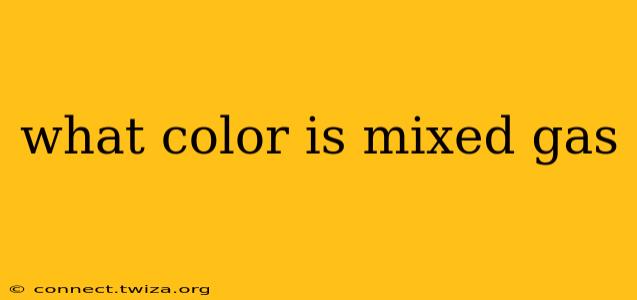What Color is Mixed Gas?
The color of "mixed gas" is highly dependent on the specific gases in the mixture and their proportions. There isn't a single definitive answer. The term "mixed gas" is very broad and encompasses numerous combinations used in various industries. Let's explore some common examples and why determining the color is complex:
What gases are typically in a mixed gas cylinder?
Mixed gas cylinders contain a variety of gases, blended to meet specific needs. These can include:
- Medical gases: These often contain oxygen, nitrous oxide, helium, and other gases in precise ratios for medical procedures like anesthesia. The color depends entirely on the dominant gas and any added coloring agents. Medical gas cylinders are usually color-coded according to international standards, but the gas mixture itself might not have a distinct color.
- Industrial gases: Industrial applications utilize mixed gases for welding, cutting, and other processes. These mixtures can contain oxygen, nitrogen, argon, carbon dioxide, and various other gases, again in varying ratios. The color here is unpredictable.
- Calibration gases: Used for instrument calibration, these precise mixtures often contain trace amounts of various gases. These are generally colorless, as the concentrations of individual gases are often too small to impart a visible color.
Why doesn't mixed gas have a single color?
The absence of a single color for mixed gas stems from several factors:
- Gas properties: Many gases are colorless in their pure form (e.g., oxygen, nitrogen, argon). A mixture of colorless gases will generally remain colorless.
- Concentration: The concentration of each component in the mixture significantly influences the overall color. Even if one gas is colored, its effect might be diluted if present in a low concentration.
- Additives: Some gas mixtures might contain additives that impart color, but this is not standard practice for all applications. These additives serve purposes other than color identification, such as corrosion inhibitors.
Are there any exceptions?
While most mixed gases lack a distinct color, some exceptions exist. For example:
- Certain refrigerant mixtures: Some refrigerant blends might contain a dye for leak detection purposes. These would appear with the color of the added dye.
- Gases with inherent color: If a mixed gas includes a gas with a naturally visible color (though this is uncommon in most mixed gas applications), the mixture will likely take on a hue influenced by this gas.
How can I determine the color of a specific mixed gas?
To determine the color of a specific mixed gas, you need to:
- Identify the gas composition: The precise composition of the mixture is crucial. The Safety Data Sheet (SDS) for the gas cylinder will specify the gases and their percentages.
- Check for additives: The SDS will also list any added substances, including those that might affect the color.
- Observe the gas: Visual inspection can provide a preliminary indication, though reliance on this method alone is unreliable.
In conclusion, there's no universal color for mixed gas. The appearance depends on the specific gases included, their concentration, and the presence of any additives. Always refer to the SDS for a specific gas mixture to understand its properties, including any relevant color information.
